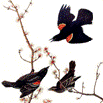Wildlife Damage Management, Internet Center for
Document Type
Article
Date of this Version
October 1973
Abstract
Ripening blueberries are subject to serious damage by a variety of bird species. Through a questionnaire survey, Pearson (1958) calculated that losses of highbush blueberries to birds in Massachusetts averaged about $38,000 a year in 1955-57. From a 1972 questionnaire on bird damage to highbush blueberries directed to individuals in 14 states, Mott and Stone (1973) estimated that birds damaged at least 5% of the crop, representing a minimum nationwide loss of about $1.6 million. Most species of birds that feed on blueberries are not only desirable but also protected under the Migratory Bird Treaties Act. Any means of reducing this damage must therefore be nonlethal. Since the experimental insecticide, methiocarb [4-methylthio)-3,5-xylyl N-methylcarbamate], has recently proved to be an effective, nonlethal repellent for protecting cherries and grapes from damage by birds (Guarino, 1972; Guarino, et al., 1974), initial trials were conducted to determine if methiocarb would protect wild, lowbush blueberries (vaccinium angustifolium) from bird damage.


